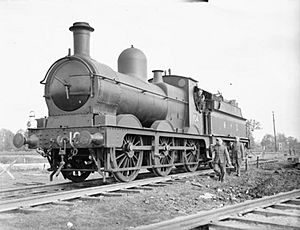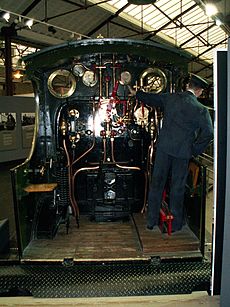GWR 2301 Class facts for kids
Quick facts for kids GWR 2301 'Dean Goods' Class |
|
 |
|
| A class member as a War Department locomotive, Royal Engineers base supply park depot, Rennes, November 1939. | |
| Power type | Steam |
|---|---|
| Designer | William Dean |
| Builder | GWR Swindon Works |
| Order number | Lots 61, 62, 63, 82, 87, 92, 99, 100, 104, 107, 108, 111 |
| Build date | 1883–1899 |
| Total production | 260 |
| Configuration | 0-6-0 |
| UIC classification | Cn2g |
| Gauge | 4 ft 8 1⁄2 in (1,435 mm) standard gauge |
| Driver diameter | 5 ft 2 in (1.575 m) |
| Locomotive weight | 36.8 long tons (37.4 t; 41.2 short tons) |
| Tender weight | 34.25 long tons (34.80 t; 38.36 short tons) |
| Fuel type | Coal |
| Boiler | GWR 2301 |
| Boiler pressure | 180 psi (1,241.06 kPa) |
| Cylinders | Two, inside |
| Cylinder size | 17 in × 24 in (432 mm × 610 mm), 17+1⁄2 in × 24 in (444 mm × 610 mm) from 1908 |
| Tractive effort | 17,120 lbf (76.15 kN) or 18,140 lbf (80.69 kN) |
| Power class | Ungrouped (17 in or 432 mm cyls, 150 psi or 1,000 kPa) A (17+1⁄2 in or 444 mm cyls, 180 psi or 1,200 kPa) |
| Axle load class | Uncoloured |
| Withdrawn | 1929-1957 |
| Disposition | One preserved, remainder scrapped |
The Dean Goods Class was a type of steam locomotive used by the Great Western Railway (GWR) in Britain. These powerful engines were designed to pull heavy goods trains. They are known as "0-6-0" locomotives, which means they have no leading wheels, six driving wheels, and no trailing wheels.
Between 1883 and 1899, the GWR built 260 of these locomotives at their Swindon railway works. They were designed by William Dean. The Dean Goods engines were special because they were among the first GWR locomotives to have only inside frames. Over time, their boiler design was also updated. The first 20 engines were built without a dome on their boiler, but later all of them were fitted with domes.
Contents
Building the Dean Goods Engines
The Dean Goods locomotives were built in batches over many years. The first engines were numbered 2301 to 2360. Later ones were numbered from 2381 to 2580. (Numbers 2361 to 2380 were for a different, but similar, class of locomotives.)
A total of 260 of these engines were made. They were built at the famous Swindon Works, which was a very important factory for the Great Western Railway.
Changing into Prairie Tank Engines
In 1907, 20 of the Dean Goods locomotives (numbers 2491-2510) were changed into a different type of engine. They became "2-6-2T 'Prairie' tank locomotives." These new engines were called the GWR 3901 Class. This shows how train companies sometimes reused parts of older engines to create new ones.
Dean Goods in War Service
These tough locomotives played a big part in both World Wars.
World War I Service
In 1917, during World War I, 62 Dean Goods engines were sent to France. They were used by the Railway Operating Division to move supplies for the army. Most of these engines returned to England in 1919. However, 16 of them were sent further away to Salonika (in Greece) in 1918.
Two of these engines, numbers 2308 and 2542, were sold to the Ottoman railways in Turkey. One of them, number 110, worked until the 1950s! The remaining 14 engines from Salonika eventually returned to England in 1921.
World War II Service
When World War II started, the War Department needed more locomotives. They took 100 Dean Goods engines from the GWR. Some engines that had been put out of service had to be quickly fixed up and brought back to work.
These engines were painted black and given new War Department numbers. Some were even fitted with special brakes and tanks. In December 1940, 8 more engines were taken.
Many of these engines were sent to France. Some were destroyed during the retreat to Dunkirk. Others were used by the German forces on French railways. After the war, some went as far as China. About 30 engines returned to the UK, but they were too worn out and were scrapped.
One engine, number 2435, had an incredible journey. It was sent to France in 1940. It then worked in Poland and Austria before being claimed by the Russians. It was finally returned to Austria in 1952. Another engine, number 2489, ended up in East Germany and worked there until 1955.
Some Dean Goods locomotives were very special because they served overseas in both World Wars! Out of 108 engines used in World War II, 32 had also been used in World War I. And 24 of those 32 were sent overseas again.
Life with British Railways
After World War II, in 1948, 54 Dean Goods locomotives became part of British Railways. They were mostly used on smaller railway lines in Wales. This was because they were lighter than other engines.
Newer, more modern engines eventually replaced them. The last Dean Goods engine, number 2538, was taken out of service in May 1957.
Preserving a Piece of History
Luckily, one Dean Goods locomotive has been saved! Engine number 2516, built in 1897, is now a static exhibit at the Swindon Steam Railway Museum. You can see its tender displayed separately, which gives visitors a clear view inside the driving cab. It's a great way to see what these historic engines looked like up close.
Images for kids



